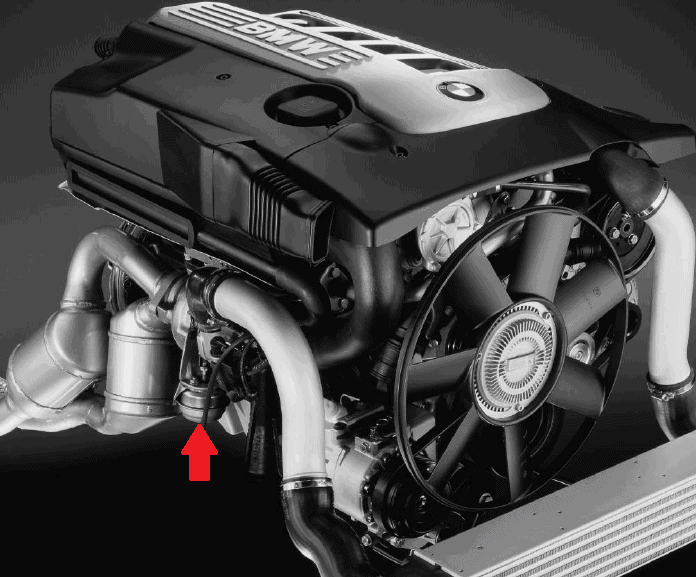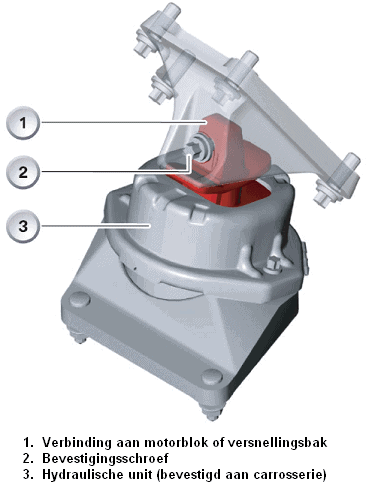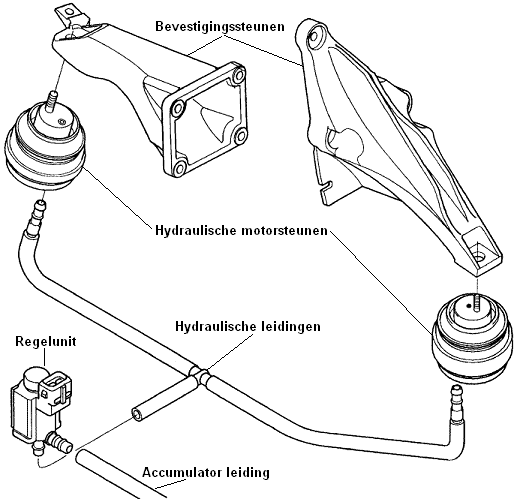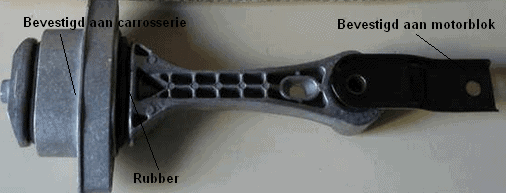Subjects:
- Engine mount
- Hydraulic motor mount
- Active (adjustable) engine mount
- pendulum support
Engine mount:
The engine of a car often has 3 engine mounts; 2 on the side and 1 on the back. On vehicles with transverse engines, the engine mounts are on the timing side, on the gearbox and on the bottom of the subframe (the pendulum mount). For longitudinal engines (such as the BMW engine in the picture below), the engine mounts on the side are exactly in the middle (where the red arrow is and of course also on the other side). There is also a support at the rear against the body against tilting.
The engine block hangs or stands in the rubber parts of the engine mounts. The motor has some play in these mounts; it may move slightly in the engine mounts. This is necessary to dampen vibrations and absorb large engine forces due to idling and movement during acceleration / deceleration.
The rubber of the engine mount must be of good quality. Not too hard, because then the vibrations will be dampened badly. Also not too soft, because then the engine can move too much and wear is greatest. The correct engine mount is designed based on the weight of the engine block.
With age, the rubbers often become weaker. This can be noticed by a “thumping” feeling and sound when the clutch is released, or sounds when suddenly accelerating or releasing the accelerator pedal. (Note, this can also have other causes such as worn wishbone rubbers, a defective dual mass flywheel, etc.)
With worn engine mounts, the engine vibrations can also be transmitted into the interior. This can be recognized as a thumping sound, or even vibrations in the passenger compartment depending on the engine speed. It is then best to replace the engine mounts before other components are destroyed by the vibrations.

Hydraulic motor mount:
Hydraulic engine mounts can be used in luxury cars. These engine mounts increase comfort, because the vibrations are damped even better than the conventional 'rubber' engine mounts. The hydraulic unit (No. 3 in the picture) contains oil under pressure. The oil sits between two parts of this support. The weight of the engine rests on the oil. This oil takes over the job of the rubber of the other support; the vibrations and movements are damped here.

Active (adjustable) engine mount:
In cars where the comfort level can be set in the on-board computer (eg BMW / Mercedes), the damping of the engine mounts can be adjusted. By activating 'sporty mode' in the on-board computer, extra oil is pumped from the accumulator through the control unit into the hydraulic engine mounts. These engine mounts become stiffer due to the larger amount of oil and can therefore move less easily. The vibrations are now also more easily transmitted to the interior. The engine now has less movement options in the engine compartment, which benefits a sporty driving style (with a lot of cornering). The additional engine vibrations can also be interpreted as sporty by the driver.
In comfort mode, the control unit releases some oil from the engine mounts. This gives, as the name suggests, more comfort. You can often choose between sporty and comfortable on a scale of 1 to 5. The damping of the air suspension is also adjusted at the same time in the same way.
For cars without adjustable engine mounts, the manufacturer has opted for a certain level of comfort. Comfort should be as high as possible, but at the same time road holding should be optimal. A compromise must always be made, whereby the car is “and comfortable, and sporty”. The rider can only adjust this by replacing parts of the wheel suspension (eg the springs and shock absorbers).

Pendulum support:
A pendulum support is an engine support that is mounted on the underside of the car. This support is mounted on the underside of the engine (at the height of the bottom of the oil pan and gearbox) and the other side is on the body or subframe. The pendulum support ensures that the engine block does not tilt when accelerating or releasing the throttle. This support is only found in cars with the engine in transverse direction (so with the hood open the cylinders are from left to right and not from front to back).

